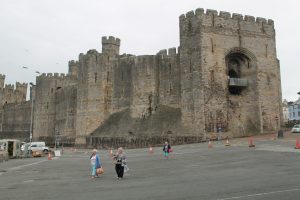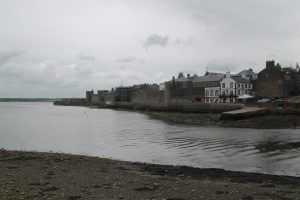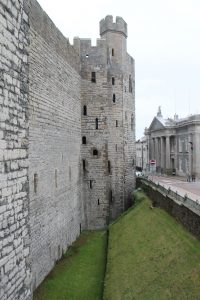Learn more about Caernarfon Castle, a World Heritage Site and one of the major fortifications built by King Edward I in his conquest of Wales.
Immediately after his conquest of Wales in 1283, Edward I began construction of his famous ring of castles that would choke the independence of Snowdonia; Conwy, Harlech and Caernarfon.
For all the stark majesty and military effectiveness of Conwy and Harlech, Caernarfon was the undoubted jewel in this iron necklace; a site of strategic and administrative importance, but also one of huge symbolic significance.
Caernarfon is on the Gwynedd mainland at the mouth of the river Seiont, a connecting point between Anglesey, the mountainous heartland of Snowdonia and the rich Llŷn peninsula.
The area had been important in Roman times, the remains of the imperial military presence still evident at the ruined camp of Segontium, half a mile south-east of where the castle was built.

After his Welsh war of 1277, Rhuddlan had been constructed as Edward’s castle for pomp, circumstance and rule in Wales.
But as his forces advanced further west, this ceremonial role was now usurped by Caernarfon.
Mythology
The importance of Caernarfon was embellished in Welsh mythology, as most clearly seen in the famous prose tale Breuddwyd Macsen Wledig (The Dream of Macsen Wledig).
Macsen was the fourth-century Roman general Magnus Maximus, who was proclaimed emperor in Britain and used troops from the island to cross to the continent and rule a portion of the western empire.
In the Welsh legend it was as emperor of Rome that Macsen dreamt of a woman who stole his heart, leading him on a quest to find the lady of his dreams.
She turned out to be Helen, the daughter of a chieftain named Euaf ap Caradog who was based in Caernarfon. Macsen’s vision of Helen’s home may have been a further inspiration for Edward’s builders and is described thus:
“He saw himself coming to the fairest island in the world [Britain], and having crossed the island from one sea to the other he could see, at the far end of the island, steep mountains and lofty crags, and rough, rugged terrain, the like of which he had never seen before. From there he saw an island in the sea, facing that rugged terrain, and between him and the island he saw a land whose plain was the length of its sea, whose forest was the length of its mountain. From that mountain he saw a river crossing the land, making for the sea, and at the mouth of the river he saw a great castle, the fairest that anyone had ever seen, and he saw the castle gate was open, and he came into the castle. He saw a hall in the castle. He thought that the roof tiles of the hall were all of gold. The side of the hall he thought to be of valuable, sparkling stones. The floors of the hall he imagined to be of pure gold, with golden couches and silver tables.”
Macsen had been deeply embedded in the mythology of Wales, symbolic of the inherited right to rule that passed from Rome to the Brythonic (‘Welsh’) leaders.
It was he who was said to have established Caernarfon as the chief fort of Britain, the island being given to Euaf to rule.
The work of Geoffrey of Monmouth helped to spread the legend of Macsen, and the genealogies of a number of princely lines proudly listed the emperor as their ancestor.
An erroneous but widespread belief also named Macsen as the father of Constantine the Great, while Geoffrey claimed that Constantine was the grandfather of King Arthur.
In the course of Edward’s 1283 campaign in Snowdonia, the king had fortuitously ‘discovered’ the body of Macsen at Caernarfon.
The construction of Caernarfon Castle
It is with this mythology in mind that we must consider the unusual and beautiful construction of Caernarfon Castle, which was built on the site where the late eleventh-century Norman adventurer Robert of Rhuddlan had established a motte and bailey castle.

If Caernarfon is compared to Harlech and Conwy, the first thing that strikes the observer is that the seven towers are not round, but polygonal.
A round tower is more effective militarily, offering a better field of fire for defenders and making the wall more difficult to undermine.
But the polygonal towers were built in deliberate imitation of Roman works, perhaps even of the Theodosian walls of Constantine’s great city of Constantinople; the Roman link is emphasised by the visually striking banded masonry seen on the southern walls of the castle.
This was a fortification built to overawe the native population with more than military might; it was an imperial statement made by a king determined to assume the mythical rights to rule of the Welsh, soon after he had wiped out their native leaders and crushed their martial independence.
To further emphasise the imperial message, in time a statue of the English king was carved above the main gate and the castle’s grandest tower, the Eagle Tower, was crowned by three turrets, each of which had a stone eagle atop.
This was not a concentric fortification; as at Conwy, the design was determined by the natural lie of the land, which dictated a narrow, figure-eight shape, with two separate enclosures.

The battlements and firing galleries built into the curtain walls and towers offered fearsome, projecting offensive power, with further protection offered by the water to the south and west and a deep ditch below the landward-facing walls.
A water gate at basement level gave crucial sea access to the garrison.
Much of the shell of the castle was constructed in the period 1284‒6, with the elaborate interior worked on in 1287, but from the earliest phases of construction the building was connected with the raising of impressive stone walls for the new town.
These stretched for almost half a mile, including eight towers and two gatehouses. Although impressive, the fact that these remained the main defence of the unfinished castle on its northern side would prove to be a weakness that could be exploited.
Caernarfon and the birth of Edward II
Edward was in Conwy on 26 March, 1284, but made a determined effort to get to Caernarfon by early April.
His wife, Eleanor of Castile, was heavily pregnant, and there is little doubt that the king wanted her to give birth at this mythologically loaded location.
A son, the future Edward II, was born on 25 April. A later story, first recorded in the sixteenth century, would claim that the king had promised the Welsh ‘a prince born in Wales, who did not speak a word of English’, and it was as such that he presented his infant child.
But the unlikeliness of this is suggested by the fact that the young Edward would not be given the royal lands in Wales until 1301, at the time of his birth he was not the king’s heir, and the royal language was French.
It was at Caernarfon, though, that Edward was presented with a key piece of paraphernalia associated with the right to rule of the native princes of Wales: a gold coronet known as ‘Arthur’s crown’.
This was sent back to London, where it was presented to the king’s eldest son, Alfonso, at the shrine of Edward the Confessor in Westminster Abbey.
The destruction and rebuilding of Caernarfon
The harsh rule of Edward’s officials from his castles sparked a huge, popular uprising in Wales in 1294.

A number of towns and baronial castles fell to the Welsh. While Edward’s royal castles were also attacked, all but one held out.
The singular exception was the king’s great showpiece construction at Caernarfon; the delay in completing the northern curtain wall had proved a costly mistake.
Edward slowly, methodically put down the Welsh rising, but he delayed returning to Caernarfon until the very end of his campaign, in late 1295.
There, the king ordered the investment of huge sums, determined to rebuild and heighten the damaged castle and town walls, with major construction work continuing until 1300.
This was an indication of his commitment to the task, at a time when urgent calls on his time and resources were coming from Gascony and Scotland.
In 1296 the enormous, mounting cost of Edward’s Scottish wars meant that all royal building work was cancelled, excepting only expenditure on Beaumaris and Caernarfon.
The haste with which the work was ordered was also an indication that the possibility of future trouble in Wales continued to loom large in the king’s mind.
The grandiose structure was largely complete by 1301, when the king’s 16-year-old son Edward of Caernarfon effectively became the new Prince of Wales when he was endowed with the royal lands in the country.
If the elder Edward’s indomitable will was evident in his completion of the construction at Caernarfon, the practical realities of his situation in 1295 demanded the abandonment of one of his prized projects at the site.
The imperial, banded walls that resemble Constantinople were forgone on the damaged sections of the walls, meaning that they are only present on the southern side of the castle.
The dominating, flawed and incomplete remains of Edward’s grand design can be seen today, an appropriate symbol of the king’s achievement in conquering the Welsh.
Later history of Caernarfon Castle
The effectiveness of Edward’s castles in securing the conquest and subjugation of Wales ultimately meant that the fortifications lost their primary purpose, and over the years Caernarfon was allowed to decay.

In the early fifteenth century, though, it proved strong enough to resist the siege of the great Welsh leader Owain Glyn Dŵr in his rising against English rule.
The last time the castle saw action was in the English Civil War, when its Royalist garrison resisted three Parliamentarian sieges before they surrendered the fortification in 1646.
Unlike so many of the great Welsh castles it was not slighted afterwards; although it continued to decay, the walls and towers remained largely intact.
From the late nineteenth century, government funds were directed towards the preservation of the historic building.
In 1911 David Lloyd George, the future Prime Minister, played a large part in deciding that the castle would, for the first time, be used for the investiture of a Prince of Wales; Edward, the future King Edward VIII.
This principle was repeated when Charles was invested as Prince of Wales in 1969.
*You can read more about Edward I’s castles in Wales on our dedicated page. For more information and a full account of the events of this period, my book Edward I’s Conquest of Wales is available from Amazon and other retailers.
And remember that Dragon Tours can help you visit Caernarfon, or any of Edward I’s other Welsh castles.
